46 Famous Mysteries That Have Been Solved.
Nathan Johnson
Published
06/17/2021
in
wow
An eye-opening list of famous "mysteries" that are no longer mysterious at all.
- List View
- Player View
- Grid View
Advertisement
-
1.
 Shot in Northern California in 1967, the Patterson-Gimlin Film is almost certainly the most well-known piece of footage purporting to show Bigfoot. While the authenticity of the film is still debated by cryptozoologists and skeptics alike, they needn't bother: a 2004 book by author Greg Long revealed the entire thing as a hoax. A local laborer named Bob Heironimus wore a suit, and freely admitted to Long that he'd done so. Roger Patterson never paid anyone involved with the film, had charges filed against him to get him to return the camera he used, and likely did the whole thing as a stunt to provide for his family, as he was sick with cancer.
Shot in Northern California in 1967, the Patterson-Gimlin Film is almost certainly the most well-known piece of footage purporting to show Bigfoot. While the authenticity of the film is still debated by cryptozoologists and skeptics alike, they needn't bother: a 2004 book by author Greg Long revealed the entire thing as a hoax. A local laborer named Bob Heironimus wore a suit, and freely admitted to Long that he'd done so. Roger Patterson never paid anyone involved with the film, had charges filed against him to get him to return the camera he used, and likely did the whole thing as a stunt to provide for his family, as he was sick with cancer. -
2.
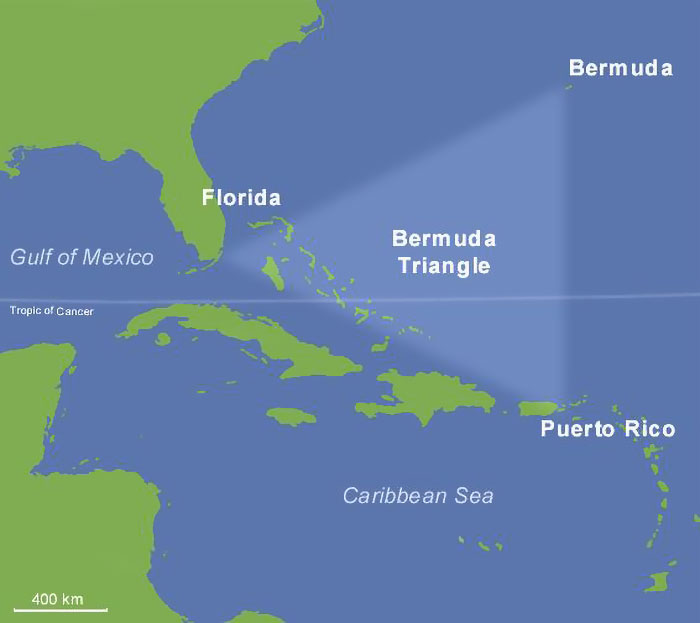 For decades, sailors, pilots, and travelers have feared the Bermuda Triangle, the vaguely triangle-shaped area of the Atlantic Ocean where at least 50 ships and 20 airplanes have "mysteriously" vanished. Stories about disappearances in the Bermuda Triangle area date back to the middle of the 19th century, but the name "Bermuda Triangle" was coined in 1964 by pulp science-fiction writer Vincent Gaddis, who wrote an article about it for Argosy magazine. Over the years, many theories have attempted to explain these disappearances, including Earth's magnetic field interfering with navigational instruments; enormous bubbles of methane gas bursting on the surface of the ocean; cryptids like sea monsters or aliens; and something to do with the lost city of Atlantis. The point is not to debunk these explanations, because the real flaw in the Bermuda Triangle theory is the premise that an unusually high number of mishaps involving ships and planes happen there. Pilot and author Larry Kusche spent years researching these disappearances, and he found that many of the reported disappearances didn't actually occur within the Bermuda Triangle. As for those shipwrecks and plane incidents, Kusche and others like the National Oceanographic and Atmospheric Administration have pointed out that maritime disasters occur at about the same rate within the Triangle as they do everywhere else.
For decades, sailors, pilots, and travelers have feared the Bermuda Triangle, the vaguely triangle-shaped area of the Atlantic Ocean where at least 50 ships and 20 airplanes have "mysteriously" vanished. Stories about disappearances in the Bermuda Triangle area date back to the middle of the 19th century, but the name "Bermuda Triangle" was coined in 1964 by pulp science-fiction writer Vincent Gaddis, who wrote an article about it for Argosy magazine. Over the years, many theories have attempted to explain these disappearances, including Earth's magnetic field interfering with navigational instruments; enormous bubbles of methane gas bursting on the surface of the ocean; cryptids like sea monsters or aliens; and something to do with the lost city of Atlantis. The point is not to debunk these explanations, because the real flaw in the Bermuda Triangle theory is the premise that an unusually high number of mishaps involving ships and planes happen there. Pilot and author Larry Kusche spent years researching these disappearances, and he found that many of the reported disappearances didn't actually occur within the Bermuda Triangle. As for those shipwrecks and plane incidents, Kusche and others like the National Oceanographic and Atmospheric Administration have pointed out that maritime disasters occur at about the same rate within the Triangle as they do everywhere else. -
3.
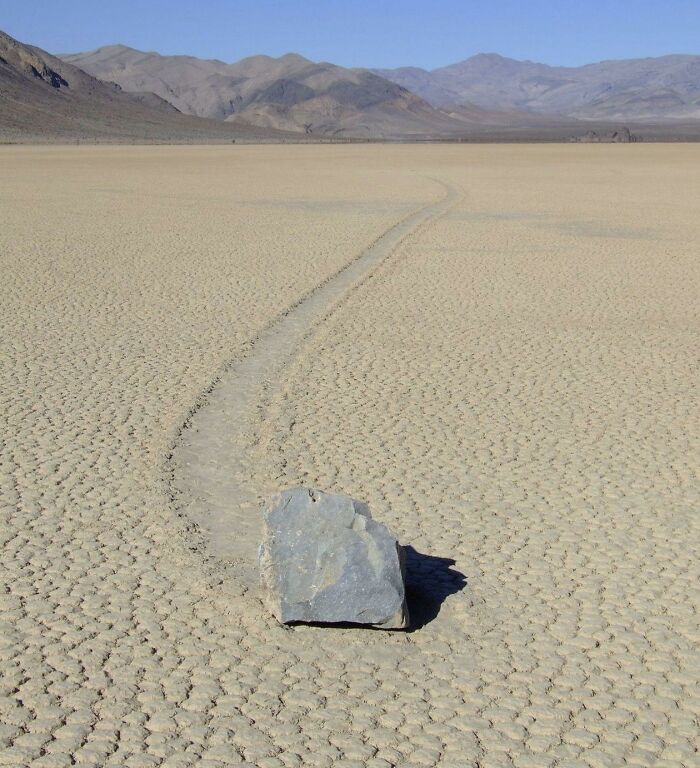 The Racetrack Playa is a flat, dry lakebed in the middle of a desert with the lowest elevation in North America. It's also home to mysterious "sailing stones" that have baffled visitors since the early 1900s. To an untrained observer, it looks like these stones have moved across the surface of the lakebed entirely on their own, leaving tracks up to 1,500 feet long without any sign of human or animal interference. Many theories have been offered to explain this phenomenon, including strong winds, the pull of the Earth's magnetic field, a clever prankster - or, once again, aliens. But thanks to a devoted team of scientists, we now know why these stones move. In 2011, researchers from the Scripps Institute of Oceanography attached GPS devices to 15 rocks and left to monitor them. Two years later, they returned to the site and were lucky enough to witness the phenomenon in person. When Death Valley receives a rare winter rainstorm, water can pool on the flat lakebed and freeze overnight, creating large panes of ice around the rocks. In the morning, the ice thaws and cracks into large sheets, and a light gust of wind is all that's needed to move the ice across the lakebed's surface. The ice sheets push the rocks across the lakebed and then melt, leaving nothing behind but the rock's tracks. The scientists called the phenomenon "ice shoving." One of them jokingly described the study as "the most boring experiment ever."
The Racetrack Playa is a flat, dry lakebed in the middle of a desert with the lowest elevation in North America. It's also home to mysterious "sailing stones" that have baffled visitors since the early 1900s. To an untrained observer, it looks like these stones have moved across the surface of the lakebed entirely on their own, leaving tracks up to 1,500 feet long without any sign of human or animal interference. Many theories have been offered to explain this phenomenon, including strong winds, the pull of the Earth's magnetic field, a clever prankster - or, once again, aliens. But thanks to a devoted team of scientists, we now know why these stones move. In 2011, researchers from the Scripps Institute of Oceanography attached GPS devices to 15 rocks and left to monitor them. Two years later, they returned to the site and were lucky enough to witness the phenomenon in person. When Death Valley receives a rare winter rainstorm, water can pool on the flat lakebed and freeze overnight, creating large panes of ice around the rocks. In the morning, the ice thaws and cracks into large sheets, and a light gust of wind is all that's needed to move the ice across the lakebed's surface. The ice sheets push the rocks across the lakebed and then melt, leaving nothing behind but the rock's tracks. The scientists called the phenomenon "ice shoving." One of them jokingly described the study as "the most boring experiment ever." -
4.
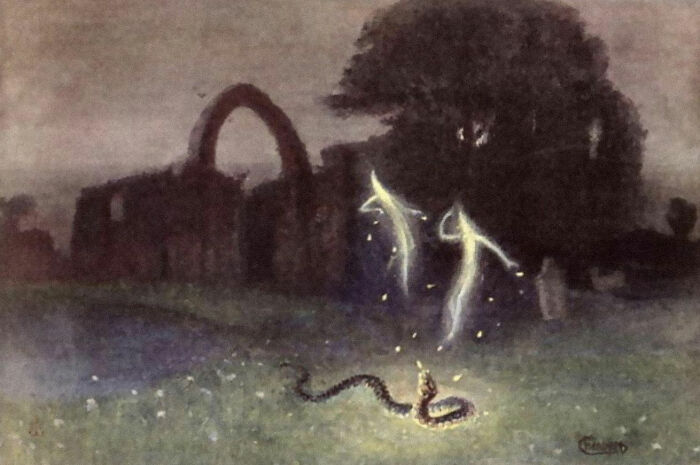 European folklore is full of fantastical creatures, from leprechauns to boggarts to the Baba Yaga, and one of the most enduring folk myths is the "will-o'-the-wisp." Throughout history, people have reported seeing mysterious flickering lights floating over marshes and swamplands at night. Witnesses have speculated these lights are spirits stuck in limbo and wandering the Earth. Often, a will-o'-the-wisp sighting is considered a bad omen. Although the term originates from Great Britain, will-o'-the-wisps appear in different cultures around the world. "Comparative mythology" is a term used when different societies have similar myths. Different cultures can have nearly identical folklore either because their folklore reflects a universal human concern (i.e. a belief in the afterlife) or they're all inspired by the same natural phenomenon. In this case, it's the latter. Most likely, will-o'-the-wisp reports are really just swamp gas sightings. Usually when organic matter perishes, it decomposes. But in swamps, lifeless organic matter gets submerged and decomposes underground, without exposure to the air. This decomposition creates "swamp gas," a combination of methane, carbon dioxide, nitrogen, phosphines, and other chemicals. When swamp gas does get exposed to the air, it can spontaneously ignite and cause a flickering effect like the will-o'-the-wisp.
European folklore is full of fantastical creatures, from leprechauns to boggarts to the Baba Yaga, and one of the most enduring folk myths is the "will-o'-the-wisp." Throughout history, people have reported seeing mysterious flickering lights floating over marshes and swamplands at night. Witnesses have speculated these lights are spirits stuck in limbo and wandering the Earth. Often, a will-o'-the-wisp sighting is considered a bad omen. Although the term originates from Great Britain, will-o'-the-wisps appear in different cultures around the world. "Comparative mythology" is a term used when different societies have similar myths. Different cultures can have nearly identical folklore either because their folklore reflects a universal human concern (i.e. a belief in the afterlife) or they're all inspired by the same natural phenomenon. In this case, it's the latter. Most likely, will-o'-the-wisp reports are really just swamp gas sightings. Usually when organic matter perishes, it decomposes. But in swamps, lifeless organic matter gets submerged and decomposes underground, without exposure to the air. This decomposition creates "swamp gas," a combination of methane, carbon dioxide, nitrogen, phosphines, and other chemicals. When swamp gas does get exposed to the air, it can spontaneously ignite and cause a flickering effect like the will-o'-the-wisp. -
5.
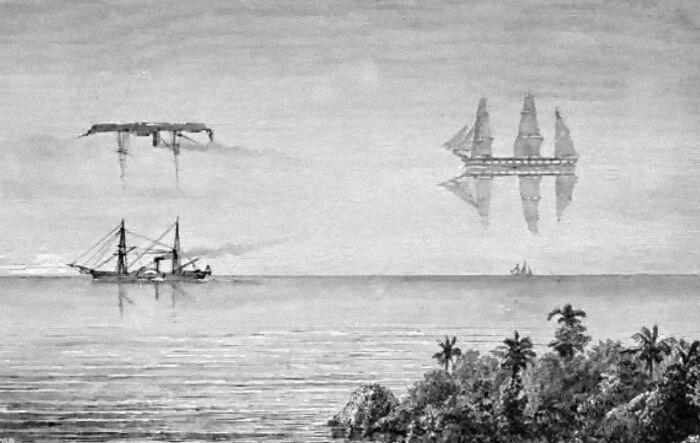 Practically since sailing was first invented, sailors have reported seeing mysterious floating objects on the horizon. The most famous of these is the "Flying Dutchman," sightings of which likely originated in the 1600s - but persisted into the 20th century. Usually, these sightings had similar details: A ghostly ship appears just over the horizon, appearing to be lit by some kind of unearthly light, usually during a storm. Sailors theorized that this ghost ship was a former Dutch trading vessel doomed to sail the ocean for eternity, and whenever it appeared before living sailors, it was a bad omen. Poems about ghost ships helped spread these legends even further, like Walter Scott's Rokeby or Samuel Taylor Coleridge's The Rime of the Ancient Mariner. Ghost ships are just one type of unearthly object people have spotted at sea. In 1643, the Jesuit priest Domenico Giardina reported seeing a floating city over the strait of Messina, just over the horizon. In 1810, cartographers Yakov Sannikov and Matvei Gedenschtrom reported seeing a floating land mass among the New Siberian Islands. In reality, reports of ghost ships, ghost cities, and ghost islands are all examples of a common optical illusion called "Fata Morgana." (The name derives from the character Morgan le Fay, a sorceress from the legend of King Arthur who could create beguiling illusions.) A Fata Morgana is caused by the way our eye perceives light when it passes through spaces with different densities. At the ocean's surface, the water keeps the air relatively cool. Above that layer of cool air is another layer of warmer air. These differences in temperature create atmospheric layers with different densities. When light passes through them, it refracts, or bends. The human eye assumes the light it can see travels in a straight line, so from a distance, refraction can make an object on the water's surface appear as if it's floating above it. Most likely, superstitious sailors probably were seeing real ships. They just looked like they were floating in the air. Fata Morganas are convincing enough that even though we now know their cause, we can still fall for them. In 2015, residents of Foshan and Jiangxi reported seeing a floating city in the sky. Once again, it was just a mirage.
Practically since sailing was first invented, sailors have reported seeing mysterious floating objects on the horizon. The most famous of these is the "Flying Dutchman," sightings of which likely originated in the 1600s - but persisted into the 20th century. Usually, these sightings had similar details: A ghostly ship appears just over the horizon, appearing to be lit by some kind of unearthly light, usually during a storm. Sailors theorized that this ghost ship was a former Dutch trading vessel doomed to sail the ocean for eternity, and whenever it appeared before living sailors, it was a bad omen. Poems about ghost ships helped spread these legends even further, like Walter Scott's Rokeby or Samuel Taylor Coleridge's The Rime of the Ancient Mariner. Ghost ships are just one type of unearthly object people have spotted at sea. In 1643, the Jesuit priest Domenico Giardina reported seeing a floating city over the strait of Messina, just over the horizon. In 1810, cartographers Yakov Sannikov and Matvei Gedenschtrom reported seeing a floating land mass among the New Siberian Islands. In reality, reports of ghost ships, ghost cities, and ghost islands are all examples of a common optical illusion called "Fata Morgana." (The name derives from the character Morgan le Fay, a sorceress from the legend of King Arthur who could create beguiling illusions.) A Fata Morgana is caused by the way our eye perceives light when it passes through spaces with different densities. At the ocean's surface, the water keeps the air relatively cool. Above that layer of cool air is another layer of warmer air. These differences in temperature create atmospheric layers with different densities. When light passes through them, it refracts, or bends. The human eye assumes the light it can see travels in a straight line, so from a distance, refraction can make an object on the water's surface appear as if it's floating above it. Most likely, superstitious sailors probably were seeing real ships. They just looked like they were floating in the air. Fata Morganas are convincing enough that even though we now know their cause, we can still fall for them. In 2015, residents of Foshan and Jiangxi reported seeing a floating city in the sky. Once again, it was just a mirage. -
6.
 For millions of Christians, the Shroud of Turin is one of the most revered religious icons in the world. The shroud is a 14-foot piece of linen fabric that was purportedly used to wrap Jesus's body for burial. Most remarkably, the shroud features a negative image of an adult male, supposedly Jesus himself. The image, some have suggested, is actually an incredibly detailed bloodstain left by Jesus's body. Since 1578, the shroud has resided in the cathedral of San Giovanni Battista in Turin, Italy, where it attracts thousands of visitors each year. To some, the validity of a religious icon is a matter of faith, not science. But thanks to modern carbon-dating techniques, scientists have been able to prove that the Shroud of Turin couldn't have been Jesus's actual burial shroud. The Bible doesn't specify exactly what year Jesus perished, but most scholars agree it was the year 33 AD. In 1988, carbon-dating showed that the Shroud of Turin originated in the Middle Ages. Forensic scientists also examined the blood spatter patterns on the shroud and concluded they were made by someone sitting in a variety of positions, not lying flat like a cadaver. Traditionally, churches and cathedrals like San Giovanni Battista have displayed holy relics purportedly belonging to Jesus, the saints, and other important religious figures. These holy relics weren't just objects of worship, but also big moneymakers that attracted thousands of pilgrims, just like they do today. Like the Shroud of Turin, the provenances of these relics are impossible to prove. In more recent years, the Vatican has officially classified the Shroud of Turin as "an icon" rather than a literal holy relic.
For millions of Christians, the Shroud of Turin is one of the most revered religious icons in the world. The shroud is a 14-foot piece of linen fabric that was purportedly used to wrap Jesus's body for burial. Most remarkably, the shroud features a negative image of an adult male, supposedly Jesus himself. The image, some have suggested, is actually an incredibly detailed bloodstain left by Jesus's body. Since 1578, the shroud has resided in the cathedral of San Giovanni Battista in Turin, Italy, where it attracts thousands of visitors each year. To some, the validity of a religious icon is a matter of faith, not science. But thanks to modern carbon-dating techniques, scientists have been able to prove that the Shroud of Turin couldn't have been Jesus's actual burial shroud. The Bible doesn't specify exactly what year Jesus perished, but most scholars agree it was the year 33 AD. In 1988, carbon-dating showed that the Shroud of Turin originated in the Middle Ages. Forensic scientists also examined the blood spatter patterns on the shroud and concluded they were made by someone sitting in a variety of positions, not lying flat like a cadaver. Traditionally, churches and cathedrals like San Giovanni Battista have displayed holy relics purportedly belonging to Jesus, the saints, and other important religious figures. These holy relics weren't just objects of worship, but also big moneymakers that attracted thousands of pilgrims, just like they do today. Like the Shroud of Turin, the provenances of these relics are impossible to prove. In more recent years, the Vatican has officially classified the Shroud of Turin as "an icon" rather than a literal holy relic. -
7.
 Likely built sometime around 450 CE, the 23-foot-tall iron pillar found in Delhi's ancient Qutb Complex amazed both locals and scientists because of its seeming resistance to rust. Theories about the "out-of-place artifact" abounded, with one explanation being that it was built by aliens, since local people at the time couldn't have built such an element-resistant object. But recent scientific analysis showed that not only was such a feat well within the capabilities of ancient people, it also revealed exactly why the pillar doesn't rust. It's coated with a thin layer of iron hydrogen phosphate hydrate (also called misawite), which keeps the elements out. The film likely ended up on the pillar through a combination of impurities in the iron and the primitive ovens the metallurgists were using. No ancient astronauts needed.
Likely built sometime around 450 CE, the 23-foot-tall iron pillar found in Delhi's ancient Qutb Complex amazed both locals and scientists because of its seeming resistance to rust. Theories about the "out-of-place artifact" abounded, with one explanation being that it was built by aliens, since local people at the time couldn't have built such an element-resistant object. But recent scientific analysis showed that not only was such a feat well within the capabilities of ancient people, it also revealed exactly why the pillar doesn't rust. It's coated with a thin layer of iron hydrogen phosphate hydrate (also called misawite), which keeps the elements out. The film likely ended up on the pillar through a combination of impurities in the iron and the primitive ovens the metallurgists were using. No ancient astronauts needed. -
8.
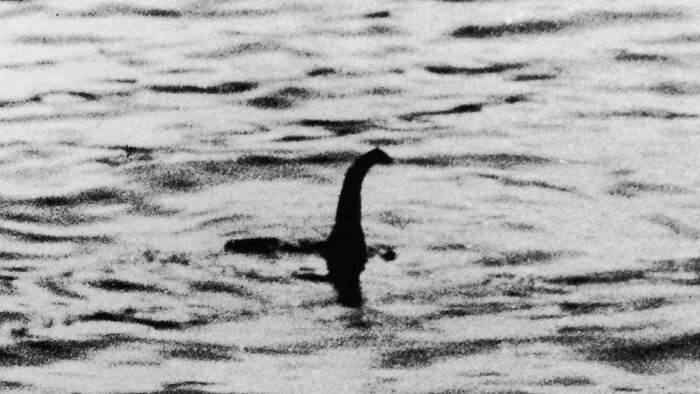 For almost 1,500 years, people have reported seeing an enormous, mysterious creature living in Loch Ness, a freshwater lake near Inverness, Scotland. The earliest reference to a Scottish lake monster dates back to the biography of Saint Columba, which was written in 565 AD. Reports continued periodically afterward, but they kicked into high gear in 1933, when a road was built along Loch Ness's shore. One year later, British doctor Robert Wilson shared the infamous Loch Ness Monster photograph, which purported to reveal the monster in its natural habitat (and in no way looks like a plastic dinosaur toy in a bathtub). Though Wilson later admitted the photo was a hoax, belief in the legend persists to this day. As of 2012, a quarter of Scots believed Nessie was real, or at least told a pollster they did. Some think the Loch Ness Monster is a prehistoric holdout, a dinosaur that somehow survived to the present day. Others think it's a cryptid. There has never been concrete proof of a lake monster living in Loch Ness, not even a washed-up carcass. So why do so many people still believe it? As with a lot of these popular myths, it's not because people are delusional, or that they're seeing something that isn't really there; it's more likely they are seeing some kind of creature and misunderstanding what it is. Skeptics have suggested that many supposed Nessie sightings are really just large fish native to the area - possibly a wels catfish, a sturgeon, or a Greenland shark. In 2019, a team of researchers from New Zealand analyzed water samples from Loch Ness and studied the DNA of every type of living organism found within it. They found no evidence of dinosaurs, sturgeon, catfish, or sharks, nor did they find the DNA of a previously unknown organism. However, they did find plenty of eel DNA. Like many freshwater lakes in Europe, Loch Ness is home to the European conger, a species of eel that spawns in the Sargasso Sea near the Bahamas and migrates to European bodies of water. European congers can grow up to 7 feet long and weigh up to 130 pounds, making them the likeliest Nessie candidate. If there is a bigger animal living in Loch Ness, it hasn't left any DNA behind.
For almost 1,500 years, people have reported seeing an enormous, mysterious creature living in Loch Ness, a freshwater lake near Inverness, Scotland. The earliest reference to a Scottish lake monster dates back to the biography of Saint Columba, which was written in 565 AD. Reports continued periodically afterward, but they kicked into high gear in 1933, when a road was built along Loch Ness's shore. One year later, British doctor Robert Wilson shared the infamous Loch Ness Monster photograph, which purported to reveal the monster in its natural habitat (and in no way looks like a plastic dinosaur toy in a bathtub). Though Wilson later admitted the photo was a hoax, belief in the legend persists to this day. As of 2012, a quarter of Scots believed Nessie was real, or at least told a pollster they did. Some think the Loch Ness Monster is a prehistoric holdout, a dinosaur that somehow survived to the present day. Others think it's a cryptid. There has never been concrete proof of a lake monster living in Loch Ness, not even a washed-up carcass. So why do so many people still believe it? As with a lot of these popular myths, it's not because people are delusional, or that they're seeing something that isn't really there; it's more likely they are seeing some kind of creature and misunderstanding what it is. Skeptics have suggested that many supposed Nessie sightings are really just large fish native to the area - possibly a wels catfish, a sturgeon, or a Greenland shark. In 2019, a team of researchers from New Zealand analyzed water samples from Loch Ness and studied the DNA of every type of living organism found within it. They found no evidence of dinosaurs, sturgeon, catfish, or sharks, nor did they find the DNA of a previously unknown organism. However, they did find plenty of eel DNA. Like many freshwater lakes in Europe, Loch Ness is home to the European conger, a species of eel that spawns in the Sargasso Sea near the Bahamas and migrates to European bodies of water. European congers can grow up to 7 feet long and weigh up to 130 pounds, making them the likeliest Nessie candidate. If there is a bigger animal living in Loch Ness, it hasn't left any DNA behind. -
9.
 The disappearance of the American pilot Amelia Earhart was one of the greatest unsolved mysteries of the 20th century. Earhart was the first woman to cross the Atlantic Ocean on a solo trip, but in July 1937 she disappeared and was never seen or heard from again. The US government even spent almost $4 billion in rescue missions but found nothing. So what happened? Looking at radio transmissions from Earhart's distress calls, it's likely that she crash landed on an island somewhere in the South-Pacific. In 1940, female bones were discovered on the island of Nikumaroro and new forensic testing in 2018, suggests that they belonged to a caucasian female. Richard Jantz, a forensic anthropologist, told National Geographic that the new evidence “strongly supports the conclusion that the Nikumaroro bones belonged to Amelia Earhart.”
The disappearance of the American pilot Amelia Earhart was one of the greatest unsolved mysteries of the 20th century. Earhart was the first woman to cross the Atlantic Ocean on a solo trip, but in July 1937 she disappeared and was never seen or heard from again. The US government even spent almost $4 billion in rescue missions but found nothing. So what happened? Looking at radio transmissions from Earhart's distress calls, it's likely that she crash landed on an island somewhere in the South-Pacific. In 1940, female bones were discovered on the island of Nikumaroro and new forensic testing in 2018, suggests that they belonged to a caucasian female. Richard Jantz, a forensic anthropologist, told National Geographic that the new evidence “strongly supports the conclusion that the Nikumaroro bones belonged to Amelia Earhart.” -
10.
 The 1945 sinking of the USS Indianapolis would go down in the US Navy history books as the greatest single loss of life by US ship. The cruiser was on a mission to deliver parts for the “Little Boy” atomic bomb at the US Army Air Force Base at Tinian. The ship completed its mission but was later hit by a torpedo from a Japanese submarine on its way to the Philippines.
The 1945 sinking of the USS Indianapolis would go down in the US Navy history books as the greatest single loss of life by US ship. The cruiser was on a mission to deliver parts for the “Little Boy” atomic bomb at the US Army Air Force Base at Tinian. The ship completed its mission but was later hit by a torpedo from a Japanese submarine on its way to the Philippines. -
11.
 The Romanovs' remains were rediscovered in 1979, and they were finally tested after the fall of the Soviet Union in 1991
The Romanovs' remains were rediscovered in 1979, and they were finally tested after the fall of the Soviet Union in 1991 -
12.
 Americans are particularly susceptible to falling for medical conspiracy theories - or, theories that suggest the US government is secretly using public health programs to control or even poison the citizenry. These theories tend to pop up whenever a new public health initiative is introduced, like water fluoridation, vaccination, or contact tracing during a pandemic. Why are these conspiracies so popular? One explanation is that they are a reaction to the "modern health worries" we all have to be concerned about. Advances in technology (transportation, X-rays, food preservation) can often lead to health problems (pollution, cancer). Studies have found that the more people are afraid of new technology and its associated health risks, the more likely they are to believe in medical conspiracy theories. This is how some people can believe in the "chemtrail theory," or the idea that the government is secretly dumping chemicals on the American public using jet engine exhaust. According to chemtrail believers, there are many reasons why the government is doing this. Some think chemtrails control the weather. Some think the government uses chemtrails to test how harmful certain chemicals are. Others think it's a way to weed out the sick and feeble. Still others think it's a form of mind control, or even mass sterilization. So, what actually are chemtrails? They are formally called "contrails," and they're simply hot air and water vapor from a jet engine that freezes on contact with Earth's very cold upper atmosphere. Just like any engine exhaust, contrails aren't entirely harmless. They contain carbon dioxide, nitrogen oxides, sulfate particles, and soot - all forms of pollution that contribute to climate change. But there's no proof contrails have ever contained any kind of unusual chemical or substance. Even if they did, any chemicals released at such high altitudes would be dispersed by the winds. So, if a shadowy organization really did want to dose the public, chemtrails would be the least effective way to do it.
Americans are particularly susceptible to falling for medical conspiracy theories - or, theories that suggest the US government is secretly using public health programs to control or even poison the citizenry. These theories tend to pop up whenever a new public health initiative is introduced, like water fluoridation, vaccination, or contact tracing during a pandemic. Why are these conspiracies so popular? One explanation is that they are a reaction to the "modern health worries" we all have to be concerned about. Advances in technology (transportation, X-rays, food preservation) can often lead to health problems (pollution, cancer). Studies have found that the more people are afraid of new technology and its associated health risks, the more likely they are to believe in medical conspiracy theories. This is how some people can believe in the "chemtrail theory," or the idea that the government is secretly dumping chemicals on the American public using jet engine exhaust. According to chemtrail believers, there are many reasons why the government is doing this. Some think chemtrails control the weather. Some think the government uses chemtrails to test how harmful certain chemicals are. Others think it's a way to weed out the sick and feeble. Still others think it's a form of mind control, or even mass sterilization. So, what actually are chemtrails? They are formally called "contrails," and they're simply hot air and water vapor from a jet engine that freezes on contact with Earth's very cold upper atmosphere. Just like any engine exhaust, contrails aren't entirely harmless. They contain carbon dioxide, nitrogen oxides, sulfate particles, and soot - all forms of pollution that contribute to climate change. But there's no proof contrails have ever contained any kind of unusual chemical or substance. Even if they did, any chemicals released at such high altitudes would be dispersed by the winds. So, if a shadowy organization really did want to dose the public, chemtrails would be the least effective way to do it. -
13.
 37. The Location Of The Santa Maria Ship Of Christopher ColumbusIn 1492, Christopher Columbus' ship the Santa Maria ran aground near Hati. Columbus recorded the location of the ship's wreckage in his journal and historians for years searched for it to no avail. That all changed in 2003, when a team of archaeologists led by Barry Clifford finally found the lost vessel. It would take years after making the discovery to determine if it was indeed the Santa Maria. Then in 2014, all the clues such as Columbus' description of the ship, an old cannon, and the wreckage itself led Clifford to concluded that it most likely is the Santa Maria.
37. The Location Of The Santa Maria Ship Of Christopher ColumbusIn 1492, Christopher Columbus' ship the Santa Maria ran aground near Hati. Columbus recorded the location of the ship's wreckage in his journal and historians for years searched for it to no avail. That all changed in 2003, when a team of archaeologists led by Barry Clifford finally found the lost vessel. It would take years after making the discovery to determine if it was indeed the Santa Maria. Then in 2014, all the clues such as Columbus' description of the ship, an old cannon, and the wreckage itself led Clifford to concluded that it most likely is the Santa Maria. -
14.
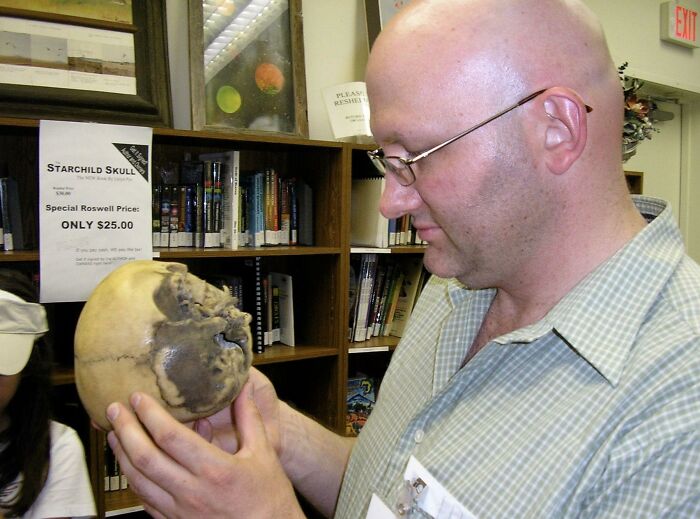 Popular myths can often inspire pop culture, but in this case, it's the other way around. In 1999, paranormalist and former Magnum, P.I. writer Lloyd Pye introduced the world to a misshapen skull he claimed as proof of extraterrestrial life. The "Starchild skull" is child-sized and features an enlarged cranium, a flattened back, and no sinuses. Pye also claimed the skull's teeth were much more worn down than a child's would be, and that it was made of organic materials unknown to science. Pye believed the skull belonged to an alien-human hybrid with a human mother and extraterrestrial father, resembling the "little grey men" depicted by sci-fi author Whitley Strieber and the TV show The X-Files. But scientists who examined the Starchild skull didn't agree. A dentist who examined the skull's teeth concluded that it belonged to a child aged about 5 years old. A neurologist found that the skull's deformations are consistent with congenital hydrocephalus, and DNA tests concluded the remains were entirely human in origin.
Popular myths can often inspire pop culture, but in this case, it's the other way around. In 1999, paranormalist and former Magnum, P.I. writer Lloyd Pye introduced the world to a misshapen skull he claimed as proof of extraterrestrial life. The "Starchild skull" is child-sized and features an enlarged cranium, a flattened back, and no sinuses. Pye also claimed the skull's teeth were much more worn down than a child's would be, and that it was made of organic materials unknown to science. Pye believed the skull belonged to an alien-human hybrid with a human mother and extraterrestrial father, resembling the "little grey men" depicted by sci-fi author Whitley Strieber and the TV show The X-Files. But scientists who examined the Starchild skull didn't agree. A dentist who examined the skull's teeth concluded that it belonged to a child aged about 5 years old. A neurologist found that the skull's deformations are consistent with congenital hydrocephalus, and DNA tests concluded the remains were entirely human in origin. -
15.
 In 1911, explorer and geographer Thomas Griffith Taylor stumbled upon a bizarre sight at the edge Taylor Glacier in East Antarctica. Taylor noted the occurrence of red blood-colored water flowing out of the glacier. At first, scientists thought it was some sort of algae that gave the water the reddish color. They eventually realized iron oxides were the reason, but how this occurred remained a mystery for over 100 years. In 2017, scientists finally discovered the source. Using radio-echo sounding radar, they were able to uncover that the waterfall was connected to an iron-rich source of water trapped under the glacier. The briny water source is believed to be over a million years old -- making Blood Falls one very strange and very old waterfall.
In 1911, explorer and geographer Thomas Griffith Taylor stumbled upon a bizarre sight at the edge Taylor Glacier in East Antarctica. Taylor noted the occurrence of red blood-colored water flowing out of the glacier. At first, scientists thought it was some sort of algae that gave the water the reddish color. They eventually realized iron oxides were the reason, but how this occurred remained a mystery for over 100 years. In 2017, scientists finally discovered the source. Using radio-echo sounding radar, they were able to uncover that the waterfall was connected to an iron-rich source of water trapped under the glacier. The briny water source is believed to be over a million years old -- making Blood Falls one very strange and very old waterfall. -
16.
 When the monastery that Richard III was buried in was bought by a private entrepreneur, his corpse was lost for centuries. The corpse of the dead king was feared gone, but scientists didn't give up hope. In 2012, they caught a lucky break when an old grave was found buried under a parking lot in Leicester. DNA testing was able to reveal that the bones in the grave were indeed the long lost remains of Richard III.
When the monastery that Richard III was buried in was bought by a private entrepreneur, his corpse was lost for centuries. The corpse of the dead king was feared gone, but scientists didn't give up hope. In 2012, they caught a lucky break when an old grave was found buried under a parking lot in Leicester. DNA testing was able to reveal that the bones in the grave were indeed the long lost remains of Richard III. -
17.
 It's one of the most prominent societal collapses in human history. The Mayans seemingly abandoned their complex civilization and disappeared into the Central American jungle. For centuries, people puzzled over the disappearance, theorizing everything from an internal peasant revolt, to conquest by an outside and unknown people, to a UFO holocaust. It wasn't until 2005 that a legitimate theory was put forward to explain what happened, a theory confirmed in 2012. The Mayan civilization collapsed due to a self-created environmental disaster. The Mayans chopped down too many trees, which reduced the land's ability to absorb solar radiation. This made rainfall more scarce, which caused a crippling drought. The Mayans abandoned their land not due to aliens or revolt, but to find food.
It's one of the most prominent societal collapses in human history. The Mayans seemingly abandoned their complex civilization and disappeared into the Central American jungle. For centuries, people puzzled over the disappearance, theorizing everything from an internal peasant revolt, to conquest by an outside and unknown people, to a UFO holocaust. It wasn't until 2005 that a legitimate theory was put forward to explain what happened, a theory confirmed in 2012. The Mayan civilization collapsed due to a self-created environmental disaster. The Mayans chopped down too many trees, which reduced the land's ability to absorb solar radiation. This made rainfall more scarce, which caused a crippling drought. The Mayans abandoned their land not due to aliens or revolt, but to find food. -
18.
 Crop circles were one of the more baffling phenomena of modern times. They usually appeared suddenly overnight. They looked like an unknown force had flattened the crops in a field into precise geometric patterns, all without damaging them. Reports of crop circles actually appear as early as the 16th century. But they became an object of public fascination in 1978, when one appeared in a field near Warminster, in Wiltshire, England. Afterward, hundreds of crop circles appeared throughout southern England and across the world. Without a scientific explanation, people came up with all sorts of theories to explain them, among meteorological forces and, of course, the usual suspect, aliens. It was believed that crop circles were actually "flying saucer nests," or sites of UFO landings. To some, they're the most concrete proof yet of extraterrestrial life. Are crop circles just another misunderstood natural phenomenon, like most of the other mysteries on this list? Nope. This time, it was all a hoax. In 1991, friends Doug Bower and Dave Chorley came forward and admitted they had created the original Wiltshire crop circle. They admitted they'd been inspired by a letter published in a 1963 issue of New Scientist about "flying saucer nests," and decided to have some fun and see if they could make one themselves. They even showed the BBC exactly how they made it: They used a contraption called a "stalk stomper," or a simple board with ropes tied on each end. One of them stood holding one end of the rope, while the other stretched the opposite end of the rope as far as it would go and walked in a circle, allowing the board to gently push over the plant stalks. Bower and Chorley admitted to making hundreds of crop circles across England, always working under the cover of darkness.
Crop circles were one of the more baffling phenomena of modern times. They usually appeared suddenly overnight. They looked like an unknown force had flattened the crops in a field into precise geometric patterns, all without damaging them. Reports of crop circles actually appear as early as the 16th century. But they became an object of public fascination in 1978, when one appeared in a field near Warminster, in Wiltshire, England. Afterward, hundreds of crop circles appeared throughout southern England and across the world. Without a scientific explanation, people came up with all sorts of theories to explain them, among meteorological forces and, of course, the usual suspect, aliens. It was believed that crop circles were actually "flying saucer nests," or sites of UFO landings. To some, they're the most concrete proof yet of extraterrestrial life. Are crop circles just another misunderstood natural phenomenon, like most of the other mysteries on this list? Nope. This time, it was all a hoax. In 1991, friends Doug Bower and Dave Chorley came forward and admitted they had created the original Wiltshire crop circle. They admitted they'd been inspired by a letter published in a 1963 issue of New Scientist about "flying saucer nests," and decided to have some fun and see if they could make one themselves. They even showed the BBC exactly how they made it: They used a contraption called a "stalk stomper," or a simple board with ropes tied on each end. One of them stood holding one end of the rope, while the other stretched the opposite end of the rope as far as it would go and walked in a circle, allowing the board to gently push over the plant stalks. Bower and Chorley admitted to making hundreds of crop circles across England, always working under the cover of darkness. -
19.
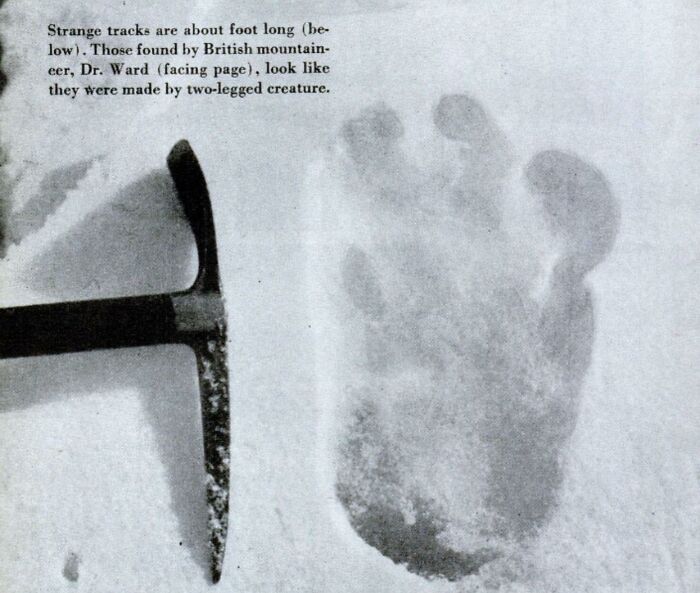 For thousands of years, native Himalayans and visitors have been convinced that the Himalayas are home to a mysterious, bipedal, apelike creature called the Yeti. (Just like Pacific Northwesterners have believed in Sasquatch.) Stories of the Yeti date all the way back to the Lepcha culture in modern-day Bhutan and Nepal, and they've persisted into modern times. But like most cryptids, there has never been concrete evidence of the Yeti's existence, like a living specimen or even a carcass. The best Yeti enthusiasts have been able to offer is shaky proof like footprints or samples of doubtful origin. In 2016, a documentary film crew gathered some of these "Yeti" samples and asked a team of biologists at the University at Buffalo to examine them. The team examined a collection of hair, bone, skin, and excrement supposedly belonging to a Yeti. DNA analysis revealed the samples mostly came from either Himalayan brown bears or black bears. Like the Loch Ness Monster, it's most likely that people have been mistaking a relatively common animal sighting for something fantastical. The fact that so many cultures around the world have reported seeing cryptids like the Yeti means one thing: Brief encounters with apex predators can confuse pretty much anyone.
For thousands of years, native Himalayans and visitors have been convinced that the Himalayas are home to a mysterious, bipedal, apelike creature called the Yeti. (Just like Pacific Northwesterners have believed in Sasquatch.) Stories of the Yeti date all the way back to the Lepcha culture in modern-day Bhutan and Nepal, and they've persisted into modern times. But like most cryptids, there has never been concrete evidence of the Yeti's existence, like a living specimen or even a carcass. The best Yeti enthusiasts have been able to offer is shaky proof like footprints or samples of doubtful origin. In 2016, a documentary film crew gathered some of these "Yeti" samples and asked a team of biologists at the University at Buffalo to examine them. The team examined a collection of hair, bone, skin, and excrement supposedly belonging to a Yeti. DNA analysis revealed the samples mostly came from either Himalayan brown bears or black bears. Like the Loch Ness Monster, it's most likely that people have been mistaking a relatively common animal sighting for something fantastical. The fact that so many cultures around the world have reported seeing cryptids like the Yeti means one thing: Brief encounters with apex predators can confuse pretty much anyone. -
20.
 Proponents for the idea that aliens from outer space had an influence on the ancient Egyptian empire have long pointed to the pyramids as evidence. How else could such large stones that were used to build the pyramids have been moved, it had to be UFOs, right? Wrong. University of Amsterdam physicists finally dispelled this argument once and for all in 2014, by looking at an ancient tomb drawing and then putting the method to the test. They were able to determine that the workers hauled the massive stone blocks on a sort of sled. By pouring water on sand or slippery clay as a type of lubricant, the workers were indeed able to reduce the friction of their path and drag the large blocks to construct the pyramids.
Proponents for the idea that aliens from outer space had an influence on the ancient Egyptian empire have long pointed to the pyramids as evidence. How else could such large stones that were used to build the pyramids have been moved, it had to be UFOs, right? Wrong. University of Amsterdam physicists finally dispelled this argument once and for all in 2014, by looking at an ancient tomb drawing and then putting the method to the test. They were able to determine that the workers hauled the massive stone blocks on a sort of sled. By pouring water on sand or slippery clay as a type of lubricant, the workers were indeed able to reduce the friction of their path and drag the large blocks to construct the pyramids. -
21.
 Woolly mammoths were largely hunted to extinction by prehistoric humans, but for decades, scientists were perplexed as to why 70 percent of mammoth fossils were males. Why were the fossil remains of females so much more rare? It wasn't until 2017, that this mystery finally was revealed when the Swedish Museum of Natural History, concluded that it was the mammoth's living arrangements that were to blame. The gender ratio of mammoths was fairly equal at birth, but upon reaching early adulthood, male mammoths were kicked out of the female-led herd. The male mammoths would then either live as loners or form small bachelor herds. Either way, they were more likely to engage in the sort of risky behavior that led to a better chance of fossil preservation -- such as becoming trapped in a bog or sinkhole.
Woolly mammoths were largely hunted to extinction by prehistoric humans, but for decades, scientists were perplexed as to why 70 percent of mammoth fossils were males. Why were the fossil remains of females so much more rare? It wasn't until 2017, that this mystery finally was revealed when the Swedish Museum of Natural History, concluded that it was the mammoth's living arrangements that were to blame. The gender ratio of mammoths was fairly equal at birth, but upon reaching early adulthood, male mammoths were kicked out of the female-led herd. The male mammoths would then either live as loners or form small bachelor herds. Either way, they were more likely to engage in the sort of risky behavior that led to a better chance of fossil preservation -- such as becoming trapped in a bog or sinkhole. -
22.
 For hundreds of years, both scholars and bystanders have written of hordes of frogs and fish falling out of the sky. Incidents date as far back as the first century CE, when Roman naturalist Pliny the Elder documented storms of frogs and fish raining down. In modern times, an incident was recorded in January 2016 in Ethiopia. Explanations for the animal rains traditionally involved waterspouts picking up the creatures from oceans or lakes and dumping them inland. Despite a number of scientific factors that make such a rain improbable, this was the accepted explanation. However, recent investigations has attributed the frogs on the ground to seasonal migrations that came out after a hard rainstorm (the same way worms do), and the fish have been determined to be any number of walking fish, of which there are dozens. Combine that with a healthy dose of confirmation bias and exaggeration, and you've got a solved mystery.
For hundreds of years, both scholars and bystanders have written of hordes of frogs and fish falling out of the sky. Incidents date as far back as the first century CE, when Roman naturalist Pliny the Elder documented storms of frogs and fish raining down. In modern times, an incident was recorded in January 2016 in Ethiopia. Explanations for the animal rains traditionally involved waterspouts picking up the creatures from oceans or lakes and dumping them inland. Despite a number of scientific factors that make such a rain improbable, this was the accepted explanation. However, recent investigations has attributed the frogs on the ground to seasonal migrations that came out after a hard rainstorm (the same way worms do), and the fish have been determined to be any number of walking fish, of which there are dozens. Combine that with a healthy dose of confirmation bias and exaggeration, and you've got a solved mystery. -
23.
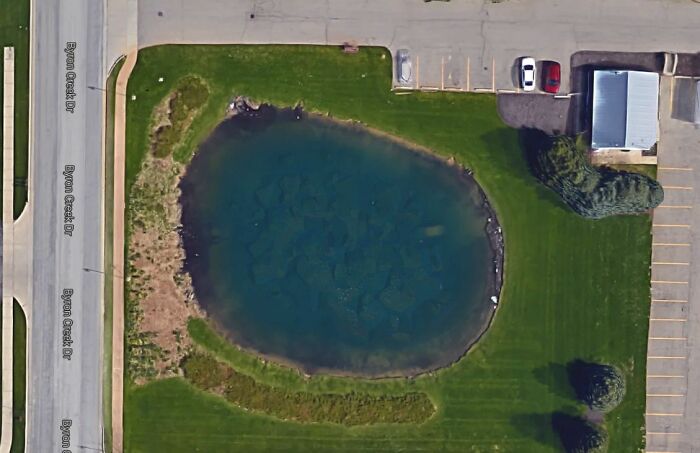 72-year-old David Lee Niles disappeared after leaving a bar in Byron Township, Michigan. Missing since 2006, Niles had been suffering from both cancer and depression, so his family had assumed he'd taken his own life, even putting out an obituary for him in 2011. It took nine years for them to figure out what happened—but the answer would turn out to be startlingly obvious. A maintenance worker installing Christmas lights with a crane on a nearby funeral home saw a car in a small lake nearby, and police divers confirmed that it was Niles when they found his wallet. But the twist is that the car was clearly visible on Google Maps. Anyone looking at the lake could have seen it.
72-year-old David Lee Niles disappeared after leaving a bar in Byron Township, Michigan. Missing since 2006, Niles had been suffering from both cancer and depression, so his family had assumed he'd taken his own life, even putting out an obituary for him in 2011. It took nine years for them to figure out what happened—but the answer would turn out to be startlingly obvious. A maintenance worker installing Christmas lights with a crane on a nearby funeral home saw a car in a small lake nearby, and police divers confirmed that it was Niles when they found his wallet. But the twist is that the car was clearly visible on Google Maps. Anyone looking at the lake could have seen it. -
24.
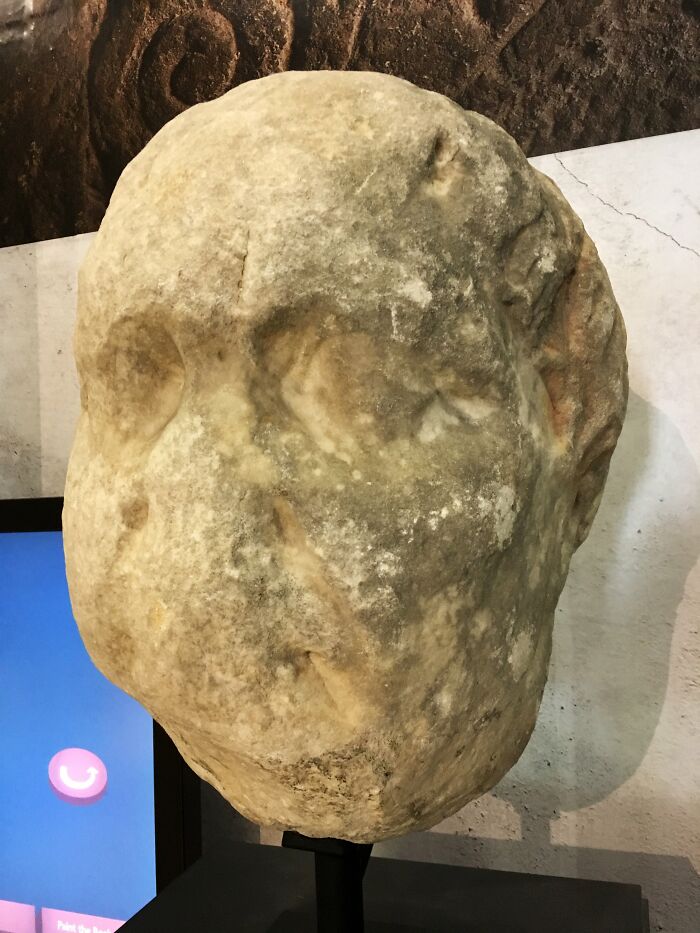 For nearly two centuries, the Bosham head remained nameless after its discovery. The head was in such poor condition that experts couldn't agree on who it was supposed to resemble. Eventually, modern technology was able to step in and solve the mystery identity behind the Bosham head. A computer scan recently helped identify the head that weighs some 350-pounds as that of Roman Emperor Trajan. It's believed the statue welcomed travelers into Chichester harbor during Roman Empire's occupation of modern-day Britain.
For nearly two centuries, the Bosham head remained nameless after its discovery. The head was in such poor condition that experts couldn't agree on who it was supposed to resemble. Eventually, modern technology was able to step in and solve the mystery identity behind the Bosham head. A computer scan recently helped identify the head that weighs some 350-pounds as that of Roman Emperor Trajan. It's believed the statue welcomed travelers into Chichester harbor during Roman Empire's occupation of modern-day Britain. -
25.
 What Was The Reason Behind The Tunguska Blast Of 1908? In 1908, the skies over Siberia lit up as a great ball of light streaked through the night sky. An enormous explosion then decimated 770 square miles of remote forest. The explosion is believed to have released energy that was 1,000 times greater than the atomic bomb. Researchers didn't reach the remote site to survey it until 1927, and were immediately perplexed at the inability to find remnants of a meteor or clear-cut impact crater. One hundred years later the site still is barren, and it wasn't until 2007 that scientists finally discovered the cause of the great blast. Researchers using acoustic imaging were able to identify the crater as a lake that was around 5 miles north of the area originally identified by scientists. A team of Italian researchers used acoustic imaging to identify the crater, which turned out to be in a lake five miles north of the spot originally identified by scientists. The explosion itself was indeed caused by a meteor.
What Was The Reason Behind The Tunguska Blast Of 1908? In 1908, the skies over Siberia lit up as a great ball of light streaked through the night sky. An enormous explosion then decimated 770 square miles of remote forest. The explosion is believed to have released energy that was 1,000 times greater than the atomic bomb. Researchers didn't reach the remote site to survey it until 1927, and were immediately perplexed at the inability to find remnants of a meteor or clear-cut impact crater. One hundred years later the site still is barren, and it wasn't until 2007 that scientists finally discovered the cause of the great blast. Researchers using acoustic imaging were able to identify the crater as a lake that was around 5 miles north of the area originally identified by scientists. A team of Italian researchers used acoustic imaging to identify the crater, which turned out to be in a lake five miles north of the spot originally identified by scientists. The explosion itself was indeed caused by a meteor. -
26.
 The Great Potato Famine was devastating to Ireland in the mid-1800s and resulted in one million deaths. Scientists new that a potato blight was to blame for the mass starvation, but the precise strain of the pathogen that triggered it was unknown until fairly recently. "We have finally discovered the identity of the exact strain that caused all this havoc," study co-author Hernán Burbano said. The study named the deadly strain HERB-1 and its discovery was the work of 11 historic samples of potato leaves that were collected about 150 years ago throughout Europe and North America. It's believed that HERB-1 didn't originate in Ireland, but emerged out of Mexico before arriving in European ports.
The Great Potato Famine was devastating to Ireland in the mid-1800s and resulted in one million deaths. Scientists new that a potato blight was to blame for the mass starvation, but the precise strain of the pathogen that triggered it was unknown until fairly recently. "We have finally discovered the identity of the exact strain that caused all this havoc," study co-author Hernán Burbano said. The study named the deadly strain HERB-1 and its discovery was the work of 11 historic samples of potato leaves that were collected about 150 years ago throughout Europe and North America. It's believed that HERB-1 didn't originate in Ireland, but emerged out of Mexico before arriving in European ports. -
27.
 In what is today northwest India and Pakistan, once stood the Indu civilization some 5,000 years ago. Cotton and date farming was prevalent in this civilization and some of the cities even had plumbing and a sewer system. What has perplexed historians for centuries is how the Indus managed all of this in the desert without a nearby river source. It's true that there was once a glacier-fed river, and for the longest time historians believed that once it dried up so did Indus civilization. However, new research reveals this wasn't the case and that the river actually vanished probably 3,000 years before the Indus collapse. To make due, the Indus relied on seasonal monson flooding to trap groundwater in the clay that could then be extracted to feed their crops.
In what is today northwest India and Pakistan, once stood the Indu civilization some 5,000 years ago. Cotton and date farming was prevalent in this civilization and some of the cities even had plumbing and a sewer system. What has perplexed historians for centuries is how the Indus managed all of this in the desert without a nearby river source. It's true that there was once a glacier-fed river, and for the longest time historians believed that once it dried up so did Indus civilization. However, new research reveals this wasn't the case and that the river actually vanished probably 3,000 years before the Indus collapse. To make due, the Indus relied on seasonal monson flooding to trap groundwater in the clay that could then be extracted to feed their crops. -
28.
 Thor Heyerdahl launched an expedition to explore the island that led to the unraveling the secrets of Easter Island and its stone idols. He led the first excavations at the site. They later discovered that the Moai heads actually have bodies, some of them reaching 20 feet in height. Their greatest discovery was their experiment that proved the statues could really be made with the tools used by the people of that time.
Thor Heyerdahl launched an expedition to explore the island that led to the unraveling the secrets of Easter Island and its stone idols. He led the first excavations at the site. They later discovered that the Moai heads actually have bodies, some of them reaching 20 feet in height. Their greatest discovery was their experiment that proved the statues could really be made with the tools used by the people of that time. -
29.
 Over two months in the summer of 2001, the state of Kerala in India was deluged by a mysterious, red-colored rain. Over a hundred thousand pounds of red particles fell, coating everything in the area. While the red rain phenomenon had happened before (documented cases go back to 1818) and would happen again, the blood rain over Kerala grabbed the imagination of scientists and pseudo-scientists alike when two researchers published a paper claiming the red particles were alien spores from an exploding, life-seeding comet. While the paper quickly became an accepted explanation for the rain, the actual cause was identified almost immediately, albeit with far less fanfare: airborne spores from local green algae. While such spores are commonly found in the atmosphere, and have been found in the other red rains around the world, there's still no explanation for why so many rained down for so long.
Over two months in the summer of 2001, the state of Kerala in India was deluged by a mysterious, red-colored rain. Over a hundred thousand pounds of red particles fell, coating everything in the area. While the red rain phenomenon had happened before (documented cases go back to 1818) and would happen again, the blood rain over Kerala grabbed the imagination of scientists and pseudo-scientists alike when two researchers published a paper claiming the red particles were alien spores from an exploding, life-seeding comet. While the paper quickly became an accepted explanation for the rain, the actual cause was identified almost immediately, albeit with far less fanfare: airborne spores from local green algae. While such spores are commonly found in the atmosphere, and have been found in the other red rains around the world, there's still no explanation for why so many rained down for so long. -
30.
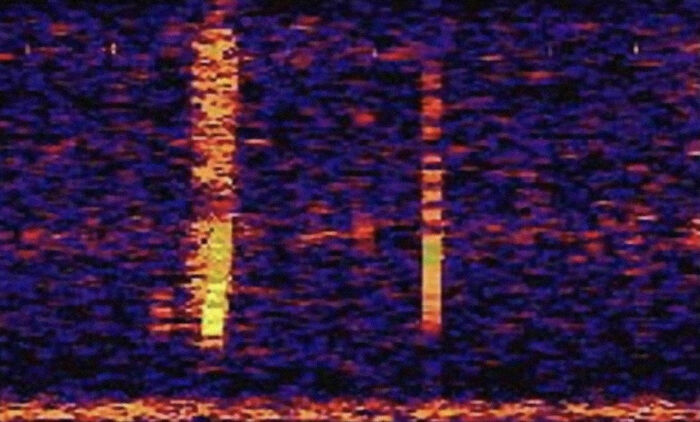 The ocean is still relatively unexplored, and some believe it's just as mysterious as the depths of outer space. Recently, a strange phenomenon seemed to give credence to the belief that unknown terrors might still lurk beneath the ocean's surface. In 1997, researchers at the National Oceanographic Atmospheric Administration (NOAA), who were using underwater hydrophones to detect volcanic activity, recorded a mysterious sound in the southern Pacific Ocean they described as a "bloop." Since the bloop sounded like it was made by an animal, similar to a whale's mating call, and because it originated over 5,000 kilometers from the listening station, some speculated that it was caused by a previously unknown sea monster. But the NOAA investigated the sound further and determined it wasn't an animal at all. By comparing the bloop's acoustics with other sound recordings taken in Antarctica, they recognized it had the same characteristics as the sound of "ice calving," AKA an "icequake," or the phenomenon of an iceberg breaking away from a glacier as it melts. Part of the confusion came from the fact that the original bloop recording was often replayed at 16 times its actual speed, which made it sound a lot less like a rumbling quake and more like an animal.
The ocean is still relatively unexplored, and some believe it's just as mysterious as the depths of outer space. Recently, a strange phenomenon seemed to give credence to the belief that unknown terrors might still lurk beneath the ocean's surface. In 1997, researchers at the National Oceanographic Atmospheric Administration (NOAA), who were using underwater hydrophones to detect volcanic activity, recorded a mysterious sound in the southern Pacific Ocean they described as a "bloop." Since the bloop sounded like it was made by an animal, similar to a whale's mating call, and because it originated over 5,000 kilometers from the listening station, some speculated that it was caused by a previously unknown sea monster. But the NOAA investigated the sound further and determined it wasn't an animal at all. By comparing the bloop's acoustics with other sound recordings taken in Antarctica, they recognized it had the same characteristics as the sound of "ice calving," AKA an "icequake," or the phenomenon of an iceberg breaking away from a glacier as it melts. Part of the confusion came from the fact that the original bloop recording was often replayed at 16 times its actual speed, which made it sound a lot less like a rumbling quake and more like an animal. -
31.
 People have been fascinated with crystal skulls long before 2008's Indiana Jones and the Kingdom of the Crystal Skull. These hunks of quartz carved into the shape of a human skull supposedly originate from pre-Columbian Mesoamerican civilizations like the Aztecs, the Mayans, the Toltecs, and the Olmecs. They first attracted worldwide attention in the late 19th century when a French antiquarian operating in Mexico City, Eugène Boban, claimed to have discovered authentic Aztec crystal skulls and sold them to a private collector. Crystal skulls soon became a sought-after collector's item, and not just because they were curiosities. Some believed the skulls had healing properties or gave their owners psychic abilities. Others believed they were related to the lost city of Atlantis, and still others believed they were of extraterrestrial origin. Crystal skulls have remained in museums like the British Museum, so modern archaeologists have been able to examine them and determine where they come from. The verdict? All evidence points to crystal skulls being fakes. For starters, no crystal skull has ever been found in situ at an authentic Mesoamerican archaeological site, meaning there's no way to prove they actually are of ancient origin. By using electron microscopes, archaeologists determined that the techniques used to make the skulls could only have been made with 19th century metal equipment, and not the stone, wooden, or bone tools Mesoamerican civilizations had access to. Most of all, the quartz used to create the skulls comes from either Brazil or Madagascar, neither of which are home to any of those four Mesoamerican civilizations. In the late 19th century, Europeans and Americans were becoming more interested in Mesoamerican cultures, and it's likely the skulls were created to capitalize on this trend.
People have been fascinated with crystal skulls long before 2008's Indiana Jones and the Kingdom of the Crystal Skull. These hunks of quartz carved into the shape of a human skull supposedly originate from pre-Columbian Mesoamerican civilizations like the Aztecs, the Mayans, the Toltecs, and the Olmecs. They first attracted worldwide attention in the late 19th century when a French antiquarian operating in Mexico City, Eugène Boban, claimed to have discovered authentic Aztec crystal skulls and sold them to a private collector. Crystal skulls soon became a sought-after collector's item, and not just because they were curiosities. Some believed the skulls had healing properties or gave their owners psychic abilities. Others believed they were related to the lost city of Atlantis, and still others believed they were of extraterrestrial origin. Crystal skulls have remained in museums like the British Museum, so modern archaeologists have been able to examine them and determine where they come from. The verdict? All evidence points to crystal skulls being fakes. For starters, no crystal skull has ever been found in situ at an authentic Mesoamerican archaeological site, meaning there's no way to prove they actually are of ancient origin. By using electron microscopes, archaeologists determined that the techniques used to make the skulls could only have been made with 19th century metal equipment, and not the stone, wooden, or bone tools Mesoamerican civilizations had access to. Most of all, the quartz used to create the skulls comes from either Brazil or Madagascar, neither of which are home to any of those four Mesoamerican civilizations. In the late 19th century, Europeans and Americans were becoming more interested in Mesoamerican cultures, and it's likely the skulls were created to capitalize on this trend. -
32.
 People have claimed to have seen unidentified flying objects for millennia - the Roman historian Livy recorded reports of them, and so did the Puritans - but in the 20th century, reports of an extraterrestrial crash near Area 51 kicked UFO speculation into high gear. It all started in 1947, when W.W. "Mac" Brazel and his son Vernon claimed they discovered the remnants of an alien spacecraft 80 miles north of Roswell, NM. Brazel collected the wreckage, which included metallic-looking fabric, and drove it to Roswell's Army Air Field for an explanation. Eventually, one Air Force intelligence officer told a local newspaper that the remnants were, in fact, an unidentified flying object. The story went national, and days later people across the country reported seeing more UFOs. The US government fielded over 300 reports that year. Some conspiracies pop up on their own when there's no explanation for a phenomenon. But others are actively promoted because an organization wants to keep the truth hidden. This is one of the latter examples. In 1947, the Cold War was just beginning, but the United States and the Soviet Union were already competing to develop superior nuclear WMDs. At the time, activities at the Roswell Army Air Field were highly classified. We now know it was the site of Project Mogul, a top-secret research project to develop large high-altitude weather balloons that could be used to monitor Soviet nuclear tests. The "UFO wreckage" Brazel discovered was really just one of those balloons. As for the hundreds of subsequent sightings, most likely people were spotting more weather balloons, which were silver-colored and large enough to look like aircraft. Some reports of "unidentified flying objects" were probably spy plane prototypes, like the U-2 - which was also tested at Area 51. Alternatively, some sightings were probably visual hallucinations. As for the intelligence officer who claimed the Brazels found an alien spacecraft - the UFO explanation was the perfect cover to keep Project Mogul secret.
People have claimed to have seen unidentified flying objects for millennia - the Roman historian Livy recorded reports of them, and so did the Puritans - but in the 20th century, reports of an extraterrestrial crash near Area 51 kicked UFO speculation into high gear. It all started in 1947, when W.W. "Mac" Brazel and his son Vernon claimed they discovered the remnants of an alien spacecraft 80 miles north of Roswell, NM. Brazel collected the wreckage, which included metallic-looking fabric, and drove it to Roswell's Army Air Field for an explanation. Eventually, one Air Force intelligence officer told a local newspaper that the remnants were, in fact, an unidentified flying object. The story went national, and days later people across the country reported seeing more UFOs. The US government fielded over 300 reports that year. Some conspiracies pop up on their own when there's no explanation for a phenomenon. But others are actively promoted because an organization wants to keep the truth hidden. This is one of the latter examples. In 1947, the Cold War was just beginning, but the United States and the Soviet Union were already competing to develop superior nuclear WMDs. At the time, activities at the Roswell Army Air Field were highly classified. We now know it was the site of Project Mogul, a top-secret research project to develop large high-altitude weather balloons that could be used to monitor Soviet nuclear tests. The "UFO wreckage" Brazel discovered was really just one of those balloons. As for the hundreds of subsequent sightings, most likely people were spotting more weather balloons, which were silver-colored and large enough to look like aircraft. Some reports of "unidentified flying objects" were probably spy plane prototypes, like the U-2 - which was also tested at Area 51. Alternatively, some sightings were probably visual hallucinations. As for the intelligence officer who claimed the Brazels found an alien spacecraft - the UFO explanation was the perfect cover to keep Project Mogul secret. -
33.
 One of the most famous and tragic photos of the 20th century is the Hindenburg blimp exploding into flames. The hydrogen-filled airship that promised a luxurious and quick crossing of the Atlantic burst into flames in May of 1937, killing 35 of its 100 passengers. Scientists knew that a spark somehow ignited the leaking hydrogen, but debated for decades on the cause of the spark and the gas leak. In 2013, aeronautical engineers finally ruled out all previous theories and determined that a thunderstorm had created a charge of static electricity in the Hindenburg. As for the gas leak, that was due to either a faulty valve or broken wire that sent hydrogen into the ventilation shafts. Experiments revealed that a static electricity spark perfectly mimicked the Hindenburg's burn pattern.
One of the most famous and tragic photos of the 20th century is the Hindenburg blimp exploding into flames. The hydrogen-filled airship that promised a luxurious and quick crossing of the Atlantic burst into flames in May of 1937, killing 35 of its 100 passengers. Scientists knew that a spark somehow ignited the leaking hydrogen, but debated for decades on the cause of the spark and the gas leak. In 2013, aeronautical engineers finally ruled out all previous theories and determined that a thunderstorm had created a charge of static electricity in the Hindenburg. As for the gas leak, that was due to either a faulty valve or broken wire that sent hydrogen into the ventilation shafts. Experiments revealed that a static electricity spark perfectly mimicked the Hindenburg's burn pattern. -
34.
 During a nine-month period in 1898, two lions named "The Ghost" and "The Darkness" killed and ate an estimated 135 railroad workers in Kenya. The story was a worldwide sensation in the newspapers and even resulted in a Hollywood movie in the 1990s. What perplexed animal experts was why the lions had developed an insatiable taste for human flesh before they were finally shot dead. In the past, experts believed it was hunger but new research in a jaw study of lions suggest it was likely jaw pain. Researchers believe that jaw pain in the lions would have made hunting and killing their normal large prey incredibly painful and picking off humans was easier on the lions' jaws.
During a nine-month period in 1898, two lions named "The Ghost" and "The Darkness" killed and ate an estimated 135 railroad workers in Kenya. The story was a worldwide sensation in the newspapers and even resulted in a Hollywood movie in the 1990s. What perplexed animal experts was why the lions had developed an insatiable taste for human flesh before they were finally shot dead. In the past, experts believed it was hunger but new research in a jaw study of lions suggest it was likely jaw pain. Researchers believe that jaw pain in the lions would have made hunting and killing their normal large prey incredibly painful and picking off humans was easier on the lions' jaws. -
35.
 It Wasn't Scarlet Fever That Caused Mary Ingalls' Blindess. If you’re a fan of the Little House on the Prairie book, you may recall that author Laura Ingalls Wilder’s real-life sister Mary allegedly went blind from scarlet fever at age 14. But although Mary Ingalls did indeed suffer from scarlet fever as a kid, and it can be a cause of blindness for some patients, physicians believe that wasn't the case with Mary. Dr. Beth Tarini and her team discovered a letter written to Laura's daughter in 1937 that mentioned Mary's blindness. But it also mentioned that Mary had "some sort of spinal sickness." Turns out, a doctor at the time inspected the nerves in Mary's eyes and they were paralyzed. As Dr. Tarini dove deeper into the medical mystery, she found the articles from the local newspaper that said in Mary's teenage years she suffered severe headaches and partial paralysis on one side of her face. The researchers came to a conclusion that it wasn't scarlet fever that caused Mary's blindness, but viral meningoencephalitis. The disease inflames the brain and spinal cord and can cause blindness in the optic nerves.
It Wasn't Scarlet Fever That Caused Mary Ingalls' Blindess. If you’re a fan of the Little House on the Prairie book, you may recall that author Laura Ingalls Wilder’s real-life sister Mary allegedly went blind from scarlet fever at age 14. But although Mary Ingalls did indeed suffer from scarlet fever as a kid, and it can be a cause of blindness for some patients, physicians believe that wasn't the case with Mary. Dr. Beth Tarini and her team discovered a letter written to Laura's daughter in 1937 that mentioned Mary's blindness. But it also mentioned that Mary had "some sort of spinal sickness." Turns out, a doctor at the time inspected the nerves in Mary's eyes and they were paralyzed. As Dr. Tarini dove deeper into the medical mystery, she found the articles from the local newspaper that said in Mary's teenage years she suffered severe headaches and partial paralysis on one side of her face. The researchers came to a conclusion that it wasn't scarlet fever that caused Mary's blindness, but viral meningoencephalitis. The disease inflames the brain and spinal cord and can cause blindness in the optic nerves. -
36.
 In 524 B.C., the army of Persian King Cambyses II made their march to fight against the Ethiopians. More than 50,000 soldiers went to conquer the oases, but all of them vanished without a trace, leaving only a legend behind. It was recently recently discovered by scientists Angelo and Alfredo Castiglioni that the legendary army that, during their 13 years of hard work, the entire army didn’t just disappear but were killed in a deadly sandstorm.
In 524 B.C., the army of Persian King Cambyses II made their march to fight against the Ethiopians. More than 50,000 soldiers went to conquer the oases, but all of them vanished without a trace, leaving only a legend behind. It was recently recently discovered by scientists Angelo and Alfredo Castiglioni that the legendary army that, during their 13 years of hard work, the entire army didn’t just disappear but were killed in a deadly sandstorm. -
37.
 On August 4, 1987, Carlina White, just 19 days old, was rushed to New York's Harlem Hospital Center. Suffering from an infection and high fever, Carlina was admitted, but disappeared during an early morning shift change. Witnesses described a heavyset woman dressed like a nurse who had been hanging around the NICU, and who left shortly after the shift change. But because the hospital's video surveillance wasn't working, nobody knew what she looked like. The incident was the first non-parental infant abduction in New York history. A reward was set up for White's return, but she was never found. The parents sued the hospital, won a settlement, and eventually split up. The case remained cold for decades. For the next 23 years, Carlina was raised under a new name by Connecticut resident Annugetta "Ann" Pettway. After becoming suspicious of her mother's inability to provide birth documents, as well as the lack of resemblance between the two, Carolina began researching on the Internet, and found baby photos that resembled her likeness as an infant. She called the National Center for Missing and Exploited Children, and was reunited with her birth parents in 2000. Pettaway disappeared, but eventually turned herself in and pleaded guilty to kidnapping. She's currently serving a 12 year sentence.
On August 4, 1987, Carlina White, just 19 days old, was rushed to New York's Harlem Hospital Center. Suffering from an infection and high fever, Carlina was admitted, but disappeared during an early morning shift change. Witnesses described a heavyset woman dressed like a nurse who had been hanging around the NICU, and who left shortly after the shift change. But because the hospital's video surveillance wasn't working, nobody knew what she looked like. The incident was the first non-parental infant abduction in New York history. A reward was set up for White's return, but she was never found. The parents sued the hospital, won a settlement, and eventually split up. The case remained cold for decades. For the next 23 years, Carlina was raised under a new name by Connecticut resident Annugetta "Ann" Pettway. After becoming suspicious of her mother's inability to provide birth documents, as well as the lack of resemblance between the two, Carolina began researching on the Internet, and found baby photos that resembled her likeness as an infant. She called the National Center for Missing and Exploited Children, and was reunited with her birth parents in 2000. Pettaway disappeared, but eventually turned herself in and pleaded guilty to kidnapping. She's currently serving a 12 year sentence. -
38.
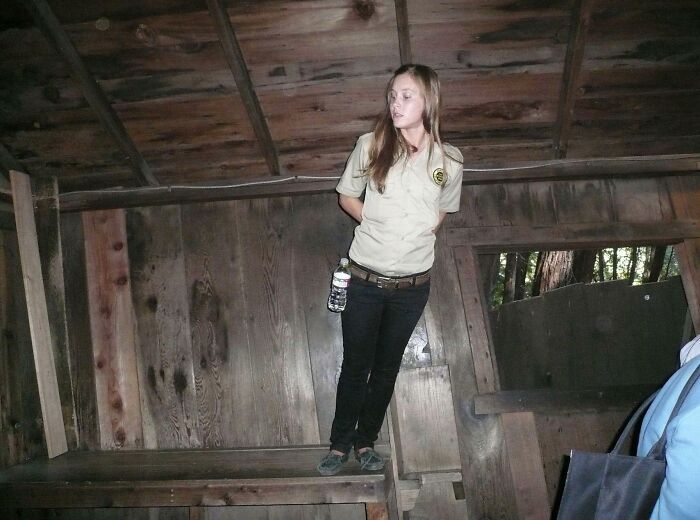 The folks who run tourist attractions like the Santa Barbara Mystery Spot would have us believe the Earth is full of areas in which the laws of physics don't apply. If you go inside one of these so-called mystery spots, you'll see strange phenomena like balls that appear to roll uphill or people standing on an incline perfectly upright, without leaning. It looks like they should topple over, but somehow they don't. At least a dozen of these mystery spots have opened around the US since the 1930s, baffling thousands of visitors every year. Without an obvious scientific explanation, people have speculated that mystery spots are caused by anything from the Bermuda Triangle to "anti-gravitational forces" influenced by UFOs. Not quite. Like the "Flying Dutchman" or a Fata Morgana, mystery spots are another optical illusion with a simple cause. But unlike those mysteries, mystery spots are purposely designed to create the effect. In 1998, a group of Berkeley psychologists studied these mystery spots and concluded that they rely on an assumption our brains make when viewing objects. The brain helps us orient ourselves horizontally and vertically in space by using the horizon as a reference point. When humans can't see the horizon, our brains use our immediate surroundings. Mystery spots like the one in Santa Barbara are built on hillsides, and their designs are purposely skewed to fool the eye. The person in this photo is simply standing upright. It's the house surrounding her that's skewed.
The folks who run tourist attractions like the Santa Barbara Mystery Spot would have us believe the Earth is full of areas in which the laws of physics don't apply. If you go inside one of these so-called mystery spots, you'll see strange phenomena like balls that appear to roll uphill or people standing on an incline perfectly upright, without leaning. It looks like they should topple over, but somehow they don't. At least a dozen of these mystery spots have opened around the US since the 1930s, baffling thousands of visitors every year. Without an obvious scientific explanation, people have speculated that mystery spots are caused by anything from the Bermuda Triangle to "anti-gravitational forces" influenced by UFOs. Not quite. Like the "Flying Dutchman" or a Fata Morgana, mystery spots are another optical illusion with a simple cause. But unlike those mysteries, mystery spots are purposely designed to create the effect. In 1998, a group of Berkeley psychologists studied these mystery spots and concluded that they rely on an assumption our brains make when viewing objects. The brain helps us orient ourselves horizontally and vertically in space by using the horizon as a reference point. When humans can't see the horizon, our brains use our immediate surroundings. Mystery spots like the one in Santa Barbara are built on hillsides, and their designs are purposely skewed to fool the eye. The person in this photo is simply standing upright. It's the house surrounding her that's skewed. -
39.
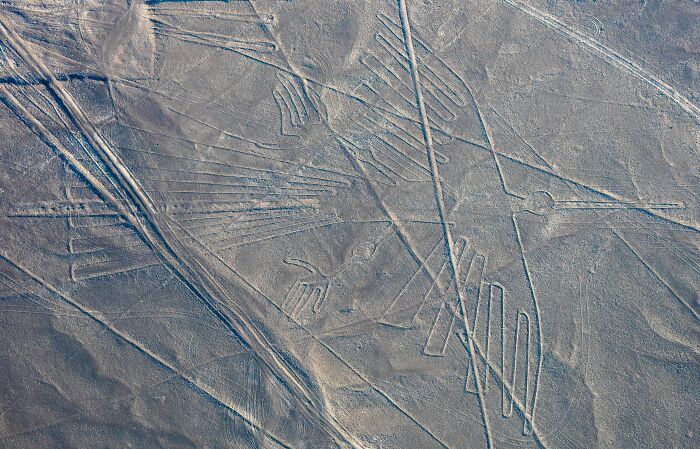 Discovered in the 1930s (when we could finally fly high enough), the Nazca Lines are massive white geoglyphs – some being 275m across – made from shallow lines dug into the ground. The whole area is about 190 square miles (500km²). They are thought to have religious significance to the Nazca culture. Given that aeroplanes are thought to have been in short supply between 500 B.C.E. and 500 C.E., how could the Nazca people see what they were doing? Author Jim Woodman thought it could have been done by using a basic hot air balloon and shouting directions to the diggers below. To test the theory, Woodman made a functioning balloon with materials they would have had back then. The only problem is there is no proof the Nazca people even knew what a balloon was. Popped that theory. However, wooden stakes at the site, carbon-dated to the Nazca period, have given researchers a hunch that people at the time may have drawn long ropes between stakes to make the lines. So Dr Joe Nickell and three assistants – including an 11-year-old – used the method to make a giant bird. And it only took them a few hours. Mystery solved.
Discovered in the 1930s (when we could finally fly high enough), the Nazca Lines are massive white geoglyphs – some being 275m across – made from shallow lines dug into the ground. The whole area is about 190 square miles (500km²). They are thought to have religious significance to the Nazca culture. Given that aeroplanes are thought to have been in short supply between 500 B.C.E. and 500 C.E., how could the Nazca people see what they were doing? Author Jim Woodman thought it could have been done by using a basic hot air balloon and shouting directions to the diggers below. To test the theory, Woodman made a functioning balloon with materials they would have had back then. The only problem is there is no proof the Nazca people even knew what a balloon was. Popped that theory. However, wooden stakes at the site, carbon-dated to the Nazca period, have given researchers a hunch that people at the time may have drawn long ropes between stakes to make the lines. So Dr Joe Nickell and three assistants – including an 11-year-old – used the method to make a giant bird. And it only took them a few hours. Mystery solved. -
40.
 The Lost Crew Of The Mary Celeste. To all the fans of marine history, which has plenty of great mysteries, this one's for you. The Mary Celestes ship was discovered adrift in the Atlantic Ocean, off the Azores Islands, on December 5, 1872. The ship wasn't in battered condition and the cargo hadn't been ransacked by pirates. So what happened to the sailors? There was not a single one of the crew members found there. Only in 2006, a chemist, Dr. Andrea Sella, managed to put an end to this mystery. Sella conducted an experiment that explained how the ship's 1,700 barrels of alcohol caught fire and created a sort of "invisible explosion." It turns out, a wall of fire swept through the ship, but it was immediately followed by cool air. That’s why there was no soot or damage done to the ship, but the crew members likely jumped overboard and abandoned the ship, fighting for their lives.
The Lost Crew Of The Mary Celeste. To all the fans of marine history, which has plenty of great mysteries, this one's for you. The Mary Celestes ship was discovered adrift in the Atlantic Ocean, off the Azores Islands, on December 5, 1872. The ship wasn't in battered condition and the cargo hadn't been ransacked by pirates. So what happened to the sailors? There was not a single one of the crew members found there. Only in 2006, a chemist, Dr. Andrea Sella, managed to put an end to this mystery. Sella conducted an experiment that explained how the ship's 1,700 barrels of alcohol caught fire and created a sort of "invisible explosion." It turns out, a wall of fire swept through the ship, but it was immediately followed by cool air. That’s why there was no soot or damage done to the ship, but the crew members likely jumped overboard and abandoned the ship, fighting for their lives. -
41.
 Paul Fronczak’s Real Identity. The story of Paul Fronczak has shaken the US as it became the second-longest cold case in US history. Still a baby, Paul was abducted from his parents and later found abandoned in a stroller in 1965. Initially, The Fronczaks were sure that they had found their lost child, but over time, doubt settled in. As Paul was getting older, the family noticed that he looked less and less like either of the Fronczaks and the family decided to order a DNA test. But in 2012, a test concluded that the child was not the Fronczaks’ and Paul suddenly had no idea who he was. Paul was eventually able to track down his true identity of Jack and learned that both his parents had died. While the mystery did help Paul Jack discover who he was, he also learned that he had a twin sister known as Jill who remains missing to this day. Unfortunately, the Fronczaks still don't know what became of their biological child either.
Paul Fronczak’s Real Identity. The story of Paul Fronczak has shaken the US as it became the second-longest cold case in US history. Still a baby, Paul was abducted from his parents and later found abandoned in a stroller in 1965. Initially, The Fronczaks were sure that they had found their lost child, but over time, doubt settled in. As Paul was getting older, the family noticed that he looked less and less like either of the Fronczaks and the family decided to order a DNA test. But in 2012, a test concluded that the child was not the Fronczaks’ and Paul suddenly had no idea who he was. Paul was eventually able to track down his true identity of Jack and learned that both his parents had died. While the mystery did help Paul Jack discover who he was, he also learned that he had a twin sister known as Jill who remains missing to this day. Unfortunately, the Fronczaks still don't know what became of their biological child either. -
42.
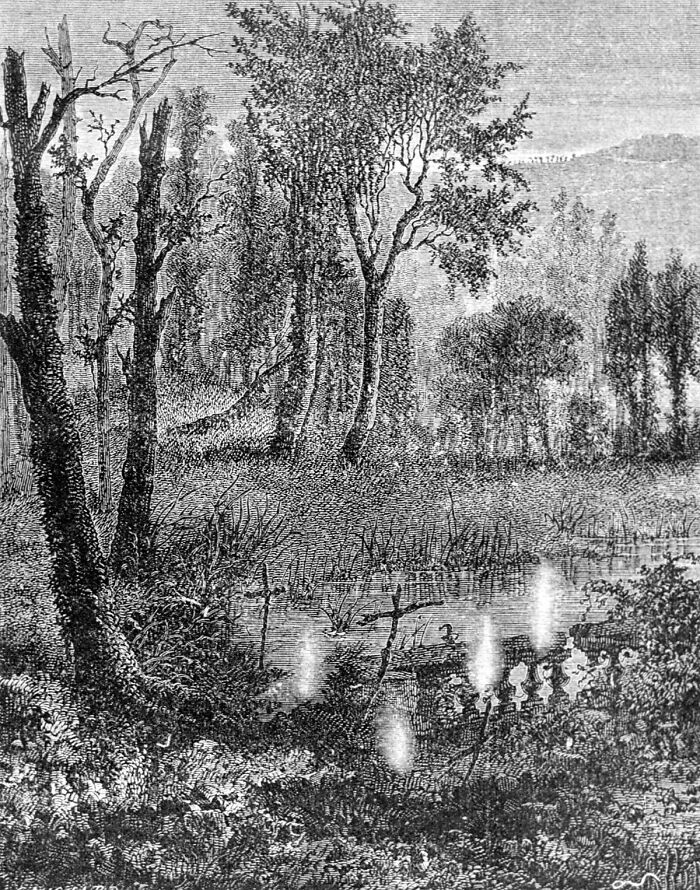 The name is a bit gross to begin with. Rather like spontaneous human combustion, but more manufactured. It’s not how it sounds, though. Back in the day, when you were transporting your dead loved one to the cemetery across the gloomy marshes, a flame or ball of light would float just above the Earth, seeming to travel with you to and from the burial ground. This was aptly named the corpse candle, following you in your time of deepest grief. Mystery and folklore surrounded this strange occurrence – many associated the corpse candle with pesky spirits of the dead, or other supernatural wanderers like stillborn and unbaptised babies that were in limbo between heaven and hell. How depressing. Science has determined that the creepy corpse candles were in fact luminescent barn owls that had fungus growing on them, or, more likely, methane gas made by rotting organic material, which is usually found in swamps and marshes. The gas can produce a low-temperature ‘flame’ through chemiluminescence. So instead of seeing an attentive spirit, you’d be witnessing the Earth doing a glow-in-the-dark fart. You’re welcome.
The name is a bit gross to begin with. Rather like spontaneous human combustion, but more manufactured. It’s not how it sounds, though. Back in the day, when you were transporting your dead loved one to the cemetery across the gloomy marshes, a flame or ball of light would float just above the Earth, seeming to travel with you to and from the burial ground. This was aptly named the corpse candle, following you in your time of deepest grief. Mystery and folklore surrounded this strange occurrence – many associated the corpse candle with pesky spirits of the dead, or other supernatural wanderers like stillborn and unbaptised babies that were in limbo between heaven and hell. How depressing. Science has determined that the creepy corpse candles were in fact luminescent barn owls that had fungus growing on them, or, more likely, methane gas made by rotting organic material, which is usually found in swamps and marshes. The gas can produce a low-temperature ‘flame’ through chemiluminescence. So instead of seeing an attentive spirit, you’d be witnessing the Earth doing a glow-in-the-dark fart. You’re welcome. -
43.
![The hieroglyphs of the ancient Egyptians have been a source of great mystery and puzzlement to historians over the centuries. While we know the meaning of many of them today, there are still some that can lead to strange theories. One of those is that the ancient Egyptians had or predicted, the invention of the helicopter. Looking at the image it does seem to somewhat look like a helicopter, but this hieroglyph discovered in the temple of Osiris doesn't refer to air travel. Egyptologists determined through restoring the original hieroglyphs that these helicopter images have simply been "tweaked" by time and deterioration. It's our brains that trick us into seeing the familiar shapes we want to see. The carving actually translates to "He who repulses the nine [enemies of Egypt]."](https://cdn.ebaumsworld.com/mediaFiles/picture/604025/86913292.jpg) The hieroglyphs of the ancient Egyptians have been a source of great mystery and puzzlement to historians over the centuries. While we know the meaning of many of them today, there are still some that can lead to strange theories. One of those is that the ancient Egyptians had or predicted, the invention of the helicopter. Looking at the image it does seem to somewhat look like a helicopter, but this hieroglyph discovered in the temple of Osiris doesn't refer to air travel. Egyptologists determined through restoring the original hieroglyphs that these helicopter images have simply been "tweaked" by time and deterioration. It's our brains that trick us into seeing the familiar shapes we want to see. The carving actually translates to "He who repulses the nine [enemies of Egypt]."
The hieroglyphs of the ancient Egyptians have been a source of great mystery and puzzlement to historians over the centuries. While we know the meaning of many of them today, there are still some that can lead to strange theories. One of those is that the ancient Egyptians had or predicted, the invention of the helicopter. Looking at the image it does seem to somewhat look like a helicopter, but this hieroglyph discovered in the temple of Osiris doesn't refer to air travel. Egyptologists determined through restoring the original hieroglyphs that these helicopter images have simply been "tweaked" by time and deterioration. It's our brains that trick us into seeing the familiar shapes we want to see. The carving actually translates to "He who repulses the nine [enemies of Egypt]." -
44.
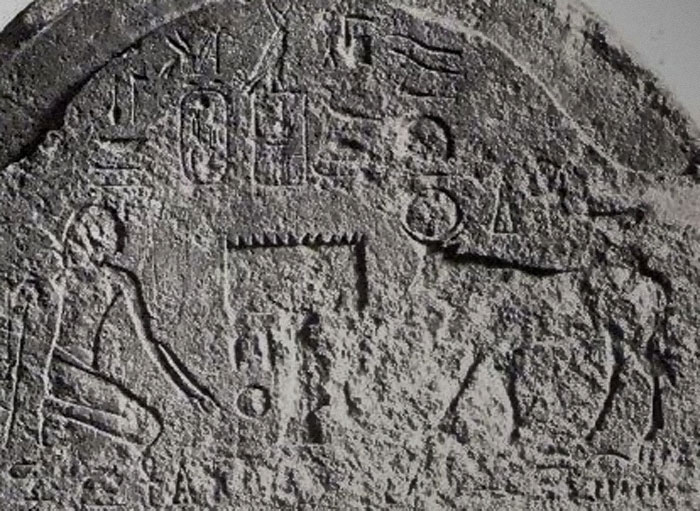 How does an army of 50,000 soldiers just vanish without a trace? That's a question that historians have pondered for centuries regarding the army of Persian King Cambyses II. In 524 BC, Cambyses moved his army to destroy the Oracle of Amun at Siwa Oasis. An army of 50,000 men entered Egypt’s western desert near Luxor, and according to Greek mythology, they were swept away by a mighty sandstorm. Historians mostly refused to believe this was possible. However, in 2009, bronze weapons and hundreds of human bones were discovered in the wilderness of the Sahara desert, lending some weight to the ancient story. "We have found the first archaeological evidence of a story reported by the Greek historian Herodotus," Dario Del Bufalo, a member of the expedition from the University of Lecce, said.
How does an army of 50,000 soldiers just vanish without a trace? That's a question that historians have pondered for centuries regarding the army of Persian King Cambyses II. In 524 BC, Cambyses moved his army to destroy the Oracle of Amun at Siwa Oasis. An army of 50,000 men entered Egypt’s western desert near Luxor, and according to Greek mythology, they were swept away by a mighty sandstorm. Historians mostly refused to believe this was possible. However, in 2009, bronze weapons and hundreds of human bones were discovered in the wilderness of the Sahara desert, lending some weight to the ancient story. "We have found the first archaeological evidence of a story reported by the Greek historian Herodotus," Dario Del Bufalo, a member of the expedition from the University of Lecce, said. -
45.
 One of the oldest copies of Homer's Oddyssey is over 500-years-old and within its pages are strange handwritten notes in an unwritten language. The strange notes eluded historians for over 200 years until Italian historians Daniele Metilli and Giulia Accetta were able to determine that the notes were a kind of French shorthand invented by Jean Coulon de Thévénot in the 1700s. A 500-year-old copy of Homer’s Odyssey featured strange handwritten notes in an unknown language. Italian computer engineers Daniele Metilli and Giulia Accetta determined that the notes were a peculiar type of shorthand invented by Jean Coulon de Thévénot. The notes are mostly translations of various parts of Greek text. The shorthand took such a long time to finally translate because each "consonant and vowel has a starting shape and they combine together to form new shapes representing syllables," said Metilli.
One of the oldest copies of Homer's Oddyssey is over 500-years-old and within its pages are strange handwritten notes in an unwritten language. The strange notes eluded historians for over 200 years until Italian historians Daniele Metilli and Giulia Accetta were able to determine that the notes were a kind of French shorthand invented by Jean Coulon de Thévénot in the 1700s. A 500-year-old copy of Homer’s Odyssey featured strange handwritten notes in an unknown language. Italian computer engineers Daniele Metilli and Giulia Accetta determined that the notes were a peculiar type of shorthand invented by Jean Coulon de Thévénot. The notes are mostly translations of various parts of Greek text. The shorthand took such a long time to finally translate because each "consonant and vowel has a starting shape and they combine together to form new shapes representing syllables," said Metilli. -
46.
![Researchers in China believe they’ve solved the 2,200-year-old mystery behind the polychrome paint of the famous Terra-Cotta Army.Discovered back in 1974, the Terra-Cotta Army is a vast collection of almost 9,000 statues representing soldiers, chariots, and horses buried with the first emperor of China, Qin Shi Huang, to serve as his imperial guard in the afterlife. When they were found, some of the sculptures still contained patches of colorful pigment and minute remnants of binding material, something exceedingly rare in statues buried underground in water-saturated sediment for over two millennia. The pigments have previously been identified—inorganic compounds such as cinnabar, azurite, and malachite—but the bonding agent and the precise method used to paint the Terra-Cotta Army remained elusive until now.To find their answer, Chinese scientists used a state-of-the-art technique called matrix-assisted laser desorption/ionization time-of-flight mass spectrometry (MALDI-TOF-MS).[4] The high levels of sensitivity provided accurate results despite trace amounts of bonding agent. The results were then compared to “artificially aged” samples of period-accurate adhesives through peptide mass fingerprinting, which identified the proteins in each specimen.According to the study, ancient Qin dynasty artists first coated the sculptures in one or two layers of lacquer obtained from a Toxicodendron tree, commonly known as the Chinese lacquer tree. Afterward, they either applied polychrome layers directly or, in most cases, used binding media made out of animal glue.](https://cdn.ebaumsworld.com/mediaFiles/picture/604025/86913295.jpg) Researchers in China believe they’ve solved the 2,200-year-old mystery behind the polychrome paint of the famous Terra-Cotta Army.Discovered back in 1974, the Terra-Cotta Army is a vast collection of almost 9,000 statues representing soldiers, chariots, and horses buried with the first emperor of China, Qin Shi Huang, to serve as his imperial guard in the afterlife. When they were found, some of the sculptures still contained patches of colorful pigment and minute remnants of binding material, something exceedingly rare in statues buried underground in water-saturated sediment for over two millennia. The pigments have previously been identified—inorganic compounds such as cinnabar, azurite, and malachite—but the bonding agent and the precise method used to paint the Terra-Cotta Army remained elusive until now.To find their answer, Chinese scientists used a state-of-the-art technique called matrix-assisted laser desorption/ionization time-of-flight mass spectrometry (MALDI-TOF-MS).[4] The high levels of sensitivity provided accurate results despite trace amounts of bonding agent. The results were then compared to “artificially aged” samples of period-accurate adhesives through peptide mass fingerprinting, which identified the proteins in each specimen.According to the study, ancient Qin dynasty artists first coated the sculptures in one or two layers of lacquer obtained from a Toxicodendron tree, commonly known as the Chinese lacquer tree. Afterward, they either applied polychrome layers directly or, in most cases, used binding media made out of animal glue.
Researchers in China believe they’ve solved the 2,200-year-old mystery behind the polychrome paint of the famous Terra-Cotta Army.Discovered back in 1974, the Terra-Cotta Army is a vast collection of almost 9,000 statues representing soldiers, chariots, and horses buried with the first emperor of China, Qin Shi Huang, to serve as his imperial guard in the afterlife. When they were found, some of the sculptures still contained patches of colorful pigment and minute remnants of binding material, something exceedingly rare in statues buried underground in water-saturated sediment for over two millennia. The pigments have previously been identified—inorganic compounds such as cinnabar, azurite, and malachite—but the bonding agent and the precise method used to paint the Terra-Cotta Army remained elusive until now.To find their answer, Chinese scientists used a state-of-the-art technique called matrix-assisted laser desorption/ionization time-of-flight mass spectrometry (MALDI-TOF-MS).[4] The high levels of sensitivity provided accurate results despite trace amounts of bonding agent. The results were then compared to “artificially aged” samples of period-accurate adhesives through peptide mass fingerprinting, which identified the proteins in each specimen.According to the study, ancient Qin dynasty artists first coated the sculptures in one or two layers of lacquer obtained from a Toxicodendron tree, commonly known as the Chinese lacquer tree. Afterward, they either applied polychrome layers directly or, in most cases, used binding media made out of animal glue.
- NEXT GALLERY
-

- Creepy.............
Shot in Northern California in 1967, the Patterson-Gimlin Film is almost certainly the most well-known piece of footage purporting to show Bigfoot. While the authenticity of the film is still debated by cryptozoologists and skeptics alike, they needn't bother: a 2004 book by author Greg Long revealed the entire thing as a hoax. A local laborer named Bob Heironimus wore a suit, and freely admitted to Long that he'd done so. Roger Patterson never paid anyone involved with the film, had charges filed against him to get him to return the camera he used, and likely did the whole thing as a stunt to provide for his family, as he was sick with cancer.
46/46
1/46
Categories:
Wow







0 Comments